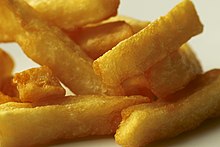
Cooking, also known as cookery or professionally as the culinary arts, is the art, science and craft of using heat to make food more palatable, digestible, nutritious, or safe. Cooking techniques and ingredients vary widely, from grilling food over an open fire, to using electric stoves, to baking in various types of ovens, reflecting local conditions.

French fries, chips, finger chips, french-fried potatoes, or simply fries are batonnet or allumette-cut deep-fried potatoes of disputed origin from Belgium or France. They are prepared by cutting potatoes into even strips, drying them, and frying them, usually in a deep fryer. Pre-cut, blanched, and frozen russet potatoes are widely used, and sometimes baked in a regular or convection oven; air fryers are small convection ovens marketed for frying potatoes.

A potato chip or crisp is a thin slice of potato that has been deep fried, baked, or air fried until crunchy. They are commonly served as a snack, side dish, or appetizer. The basic chips are cooked and salted; additional varieties are manufactured using various flavorings and ingredients including herbs, spices, cheeses, other natural flavors, artificial flavors, and additives.

Deep frying is a cooking method in which food is submerged in hot fat, traditionally lard but today most commonly oil, as opposed to the shallow oil used in conventional frying done in a frying pan. Normally, a deep fryer or chip pan is used for this; industrially, a pressure fryer or vacuum fryer may be used. Deep frying may also be performed using oil that is heated in a pot. Deep frying is classified as a hot-fat cooking method. Typically, deep frying foods cook quickly since oil has a high rate of heat conduction and all sides of the food are cooked simultaneously.
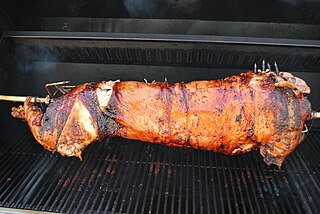
Roasting is a cooking method that uses dry heat where hot air covers the food, cooking it evenly on all sides with temperatures of at least 150 °C (300 °F) from an open flame, oven, or other heat source. Roasting can enhance the flavor through caramelization and Maillard browning on the surface of the food. Roasting uses indirect, diffused heat, and is suitable for slower cooking of meat in a larger, whole piece. Meats and most root and bulb vegetables can be roasted. Any piece of meat, especially red meat, that has been cooked in this fashion is called a roast. Meats and vegetables prepared in this way are described as "roasted", e.g., roasted chicken or roasted squash.

A slow cooker, also known as a crock-pot, is a countertop electrical cooking appliance used to simmer at a lower temperature than other cooking methods, such as baking, boiling, and frying. This facilitates unattended cooking for many hours of dishes that would otherwise be boiled: pot roast, soups, stews and other dishes.

Heston Marc Blumenthal is a British celebrity chef, TV personality and food writer. Blumenthal is regarded as a pioneer of multi-sensory cooking, food pairing and flavour encapsulation. He came to public attention with unusual recipes, such as bacon-and-egg ice cream and snail porridge. His recipes for triple-cooked chips and soft-centred Scotch eggs have been widely imitated. He has advocated a scientific approach to cooking, for which he has been awarded honorary degrees from the universities of Reading, Bristol and London and made an honorary Fellow of the Royal Society of Chemistry.

Sous vide, also known as low-temperature, long-time (LTLT) cooking, is a method of cooking invented by the French chef Georges Pralus in 1974, in which food is placed in a plastic pouch or a glass jar and cooked in a water bath for longer than usual cooking times at a precisely regulated temperature.

The Fat Duck is a fine dining restaurant in Bray, Berkshire, England, owned by the chef Heston Blumenthal. Housed in a 16th-century building, the Fat Duck opened on 16 August 1995. Although it originally served food similar to a French bistro, it soon acquired a reputation for precision and invention, and has been at the forefront of many modern culinary developments, such as food pairing, flavour encapsulation and multi-sensory cooking.

Duck confit is a French dish made with whole duck. In Gascony, according to the families perpetuating the tradition of duck confit, all the pieces of duck are used to produce the meal. Each part can have a specific destination in traditional cooking, the neck being used for example in an invigorating soup, the garbure. Duck confit is considered one of the finest French dishes. Duck confit is also a traditional ingredient in many versions of cassoulet.

Confit is any type of food that is cooked slowly over a long period as a method of preservation.

The following outline is provided as an overview of and topical guide to the preparation of food:

Boiled eggs are eggs, typically from a chicken, cooked with their shells unbroken, usually by immersion in boiling water. Hard-boiled eggs are cooked so that the egg white and egg yolk both solidify, while soft-boiled eggs may leave the yolk, and sometimes the white, at least partially liquid and raw. Boiled eggs are a popular breakfast food around the world.
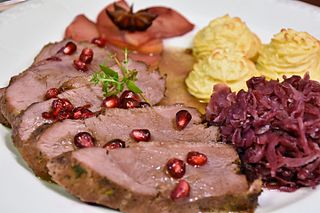
Roast goose is cooking goose meat using dry heat with hot air enveloping it evenly on all sides. Many varieties of roast goose appear in cuisines around the world, including Cantonese, European, and Middle Eastern cuisines. Roasting can enhance its flavor.

Pommes soufflées are a variety of French fried potato. Slices of potato are fried twice, once at 150 °C (302 °F) and a second time after being cooled, at 190 °C (374 °F). The potato slices puff up into little pillows during the second frying and turn golden brown.

Fried chicken, also known as Southern fried chicken, is a dish consisting of chicken pieces that have been coated with seasoned flour or batter and pan-fried, deep fried, pressure fried, or air fried. The breading adds a crisp coating or crust to the exterior of the chicken while retaining juices in the meat. Broiler chickens are most commonly used.

Crinkle-cutting is slicing that leaves a corrugated surface. It can be done to enhance the texture or mechanical properties of food. Crinkle-cutting French fries may improve their crispiness, as well as their ability to retain dipping sauce.
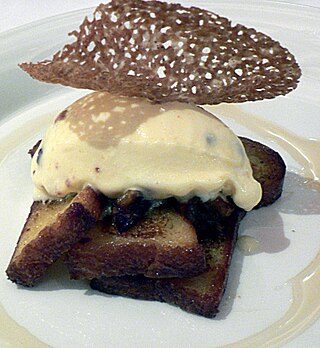
Bacon ice cream is an ice cream generally created by adding bacon to egg custard and freezing the mixture. The concept of bacon ice cream originated in a 1973 sketch on the British comedy series The Two Ronnies as a joke; it was eventually created for April Fools' Day by a New York ice cream parlour in 1982. In the 2000s, the English chef Heston Blumenthal experimented with ice cream, making a custard similar to scrambled eggs and adding bacon to create one of his signature dishes. It now appears on dessert menus in other restaurants.
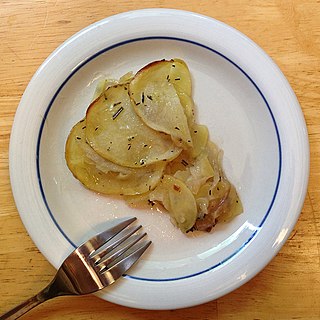
Pommes boulangère or pommes à la boulangère – "baker's potatoes" – is a savoury dish of sliced potato and onion, cooked slowly in liquid in an oven.
